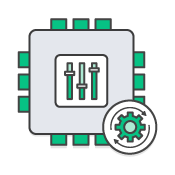AWS provides a set of flexible services designed to enable companies to more rapidly and reliably build and deliver products using AWS and DevOps practices. These services simplify provisioning and managing infrastructure, deploying application code, automating software release processes, and monitoring your application and infrastructure performance.
DevOps is the combination of cultural philosophies, practices, and tools that increases an organization’s ability to deliver applications and services at high velocity: evolving and improving products at a faster pace than organizations using traditional software development and infrastructure management processes. This speed enables organizations to better serve their customers and compete more effectively in the market.
Why AWS for DevOps?

Get Started Fast
Each AWS service is ready to use if you have an AWS account. There is no setup required or software to install.

Fully Managed Services
These services can help you take advantage of AWS resources quicker. You can worry less about setting up, installing, and operating infrastructure on your own. This lets you focus on your core product.

Large Partner Ecosystem
AWS supports a large ecosystem of partners which integrate with and extend AWS services. Use your preferred third-party and open source tools with AWS to build an end-to-end solution. Visit here to learn more about our DevOps Partner Solutions.

Pay-As-You-Go
With AWS purchase services as you need them and only for the period when you plan to use them. AWS pricing has no upfront fees, termination penalties, or long term contracts. The AWS Free Tier helps you get started with AWS. Visit the pricing pages of each service to learn more.
DevOps Tooling by AWS
AWS provides services that help you practice DevOps at your company and that are built first for use with AWS. These tools automate manual tasks, help teams manage complex environments at scale, and keep engineers in control of the high velocity that is enabled by DevOps.
Continuous Integration and Continuous Delivery
The AWS Developer Tools help you securely store and version your application's source code and automatically build, test, and deploy your application to AWS or your on-premises environment.
Start with AWS CodePipeline to build a continuous integration or continuous delivery workflow that uses AWS CodeBuild, AWS CodeDeploy, and other tools, or use each service separately.

Software Release Workflows
AWS CodePipeline
AWS CodePipeline is a continuous integration and continuous delivery service for fast and reliable application and infrastructure updates. CodePipeline builds, tests, and deploys your code every time there is a code change, based on the release process models you define. This enables you to rapidly and reliably deliver features and updates.

Build and Test Code
AWS CodeBuild
AWS CodeBuild is a fully managed build service that compiles source code, runs tests, and produces software packages that are ready to deploy. With CodeBuild, you don’t need to provision, manage, and scale your own build servers. CodeBuild scales continuously and processes multiple builds concurrently, so your builds are not left waiting in a queue.

Deployment Automation
AWS CodeDeploy
AWS CodeDeploy automates code deployments to any instance, including Amazon EC2 instances and on-premises servers. AWS CodeDeploy makes it easier for you to rapidly release new features, helps you avoid downtime during application deployment, and handles the complexity of updating your applications.

Unified CI/CD Projects
AWS CodeStar
AWS CodeStar enables you to quickly develop, build, and deploy applications on AWS. AWS CodeStar provides a unified user interface, enabling you to easily manage your software development activities in one place. With AWS CodeStar, you can set up your entire continuous delivery toolchain in minutes, allowing you to start releasing code faster.

Instacart uses AWS CodeDeploy to automate deployments for all of its front-end and back-end services. Using AWS CodeDeploy has enabled Instacart’s developers to focus on their product and worry less about deployment operations.

lululemon athletica uses a variety of AWS services to engineer a fully automated, continuous integration and delivery system. lululemon deploys artifacts distributed via Amazon S3 using AWS CodePipeline. From this stage, the artifacts are deployed to AWS Elastic Beanstalk.
Microservices
Build and deploy a microservices architecture using containers or serverless computing.

Production Docker Platform
Amazon Elastic Container Service
Amazon Elastic Container Service (ECS) is a highly scalable, high performance container management service that supports Docker containers and allows you to easily run applications on a managed cluster of Amazon EC2 instances.

Serverless Computing
AWS Lambda
AWS Lambda lets you run code without provisioning or managing servers. With Lambda, you can run code for virtually any type of application or backend service - all with zero administration. Just upload your code and Lambda takes care of everything required to run and scale your code with high availability.

Coursera uses Amazon Elastic Container Service to manage a microservices -based architecture for its applications. Coursera can now deploy software changes in minutes instead of hours in a resource-isolated environment.

Localytics uses AWS Lambda to create microservices that ingest Amazon Simple Storage Service files and Kinesis data streams comprising about 100 billion data points each month.
Infrastructure as Code
Provision, configure, and manage your AWS infrastructure resources using code and templates. Monitor and enforce infrastructure compliance.

Templated Infrastructure Provisioning
AWS CloudFormation
AWS CloudFormation gives developers and systems administrators an easy way to create and manage a collection of related AWS resources, provisioning and updating them in an orderly and predictable fashion. You can use AWS CloudFormation’s sample templates or create your own templates.

Chef Configuration Management
AWS OpsWorks
AWS OpsWorks is a configuration management service that uses Chef, an automation platform that treats server configurations as code. OpsWorks uses Chef to automate how servers are configured, deployed, and managed across your Amazon Elastic Compute Cloud (Amazon EC2) instances or on-premises compute environments. OpsWorks has two offerings, AWS Opsworks for Chef Automate, and AWS OpsWorks Stacks.

Simple built its online banking platform on AWS. Using AWS CloudFormation, Simple can automate processes that once took months to complete and focus on its customer service rather than managing IT infrastructure.

The Toronto Star is Canada’s largest online news site. By using AWS OpsWorks, the Star reduced deployment time for its content management application from 3 hours to 20 minutes, saving costs and boosting productivity.

Configuration Management
Amazon EC2 Systems Manager
Amazon EC2 Systems Manager is a management service that helps you automatically collect software inventory, apply OS patches, create system images, and configure Windows and Linux operating systems. These capabilities help you define and track system configurations, prevent drift, and maintain software compliance of your EC2 and on-premises configurations.

Policy as Code
AWS Config
AWS Config is a fully managed service that provides you with an AWS resource inventory, configuration history, and configuration change notifications to enable security and governance. Config Rules enables you to create rules that automatically check the configuration of AWS resources recorded by AWS Config.

Prezi uses AWS Config to track configuration changes to Prezi's AWS resources. AWS Config sends notifications whenever resources are created, modified, or deleted. Prezi uses AWS Config rules to govern provisioning and configuration of its resources in AWS.
Provision infrastructure from AWS CloudFormation templates, invoke Amazon EC2 Systems Manager to track your software inventory or to configure your instances, and auto-remediate any configuration drifts with AWS Config.
Monitoring and Logging
Record logs and monitor application and infrastructure performance in near real-time.

Cloud and Network Monitoring
Amazon CloudWatch
Amazon CloudWatch is a monitoring service for AWS cloud resources and the applications you run on AWS. You can use Amazon CloudWatch to collect and track metrics, collect and monitor log files, set alarms, and automatically react to changes in your AWS resources.

Distributed Tracing
AWS X-Ray
AWS X-Ray helps developers analyze and debug production, distributed applications, such as those built using a microservices architecture. With X-Ray, you can understand how your application and its underlying services are performing to identify and troubleshoot the root cause of performance issues and errors.

The Globe and Mail is Canada’s most read newspaper with a national weekly digital readership of 4.7 million. It used Amazon CloudWatch to monitor the performance of its system and adopted a DevOps approach for infrastructure automation.